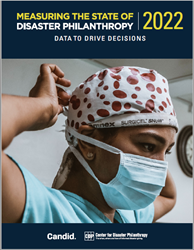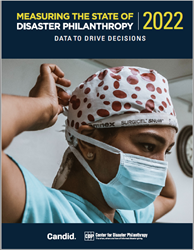
“All donors are disaster funders,” said Regine Webster, vice president at CDP. “At some point, that geography, that issue, or that population you care about is going to be affected by a disaster event.”
WASHINGTON and NEW YORK (PRWEB)
November 09, 2022
Foundation, corporate, government, and individual donors gave at unprecedented levels in 2020. A new report by Candid and the Center for Disaster Philanthropy (CDP) found nearly $121 billion in giving primarily in response to the COVID-19 pandemic. A fraction went toward other record-breaking climate-related disasters and humanitarian emergencies.
This year’s Measuring the State of Disaster Philanthropy 2022: Data to Drive Decisions report underscores philanthropy’s vital role in ensuring that disaster survivors and their communities have access to immediate relief and resources to rebuild and thrive.
Communities of color, women and girls, older adults, individuals with disabilities, LGBTQIA+ people, and other populations made vulnerable by systemic inequities are disproportionately affected by natural hazards. These communities need support to plan for, prevent, and mitigate the impact of future disasters.
The report calls on donors to give more and in ways that ensure vital resources go where they are needed most.
Key findings
As expected, COVID-19 overshadowed other disasters among donors. Of the $5.2 billion in disaster giving by institutional philanthropy, 96% went toward COVID-19, while the rest was in response to the most active Atlantic hurricane season on record; destructive earthquakes in Puerto Rico; devastating wildfires in the Amazon, Australia, and the U.S.; flooding across Asia; the humanitarian crisis in Yemen; and other disasters.
Other key findings include:
- When comparing the year-to-year giving of 222 U.S. foundations, disaster-related funding in 2020 was nearly 19 times more than in 2019 (at $2.1 billion and $110.7 million, respectively). The enormous increase in funding in 2020 was due to the COVID-19 pandemic.
- In 2020, $5.2 billion of funding to date came from foundations and public charities. Of this amount, 96% went toward COVID-19, while the remainder supported wildfires, storms, and general disaster efforts.
- Candid’s analysis of corporate public announcements found $3.6 billion in disaster-related funding from corporate giving programs.
- The Organisation for Economic Co-operation and Development’s Development Assistance Committee (DAC) distributed $36.4 billion for disasters and humanitarian crises in 2020. Non-DAC government donors and multilateral organizations contributed an additional $3.1 billion.
- The Federal Emergency Management Agency (FEMA) distributed $57.6 billion for U.S. disasters in 2020, a $54 billion increase from 2019. The U.S. Department of Housing and Urban Development (HUD) allocated $9 billion in recovery efforts in 2020, an $8 billion increase from 2019. In 2020, the U.S. Economic Development Administration (EDA) invested approximately $1.2 billion in 988 projects, an $851.8 million increase from 2019.
“Disaster philanthropy from foundations and public charities looked different in 2020, due to COVID-19,” said Grace Sato, Candid’s research director. “Far more dollars and grants were awarded than usual to address the impacts of the pandemic. Otherwise, disaster-related funding was largely unchanged compared to prior years.”
As in previous years, most institutional philanthropic giving went toward response and relief efforts, while only a fraction supported risk reduction, mitigation, preparedness, reconstruction, and recovery.
A call to action
As natural hazards and extreme weather events continue to grow and become more dangerous due in large part to climate change, their negative impact on communities increases exponentially. Under-resourced and underserved populations are especially vulnerable because of systemic inequities.
“All donors are disaster funders,” said Regine Webster, vice president at CDP. “It fundamentally does not matter what your funding focus is. At some point, that geography, that issue, or that population you care about is going to be affected by a disaster event.”
The report asks donors to consider disasters in their giving, especially efforts to address climate change. It highlights the following equity-centered practices to maximize donors’ impact:
- Address root causes.
- Prioritize local organizations.
- Provide unrestricted multi-year funding.
- Don’t forget to support preparedness, mitigation, and recovery.
The report also notes the need for grantmakers to share their giving data with Candid for a more accurate picture of giving trends.
Measuring the State of Disaster Philanthropy 2022: Data to Drive Decisions is available at doi.org/10/gq4k9v.
About Candid
Candid is a 501(c)(3) nonprofit organization that provides the most comprehensive data and insights about the social sector. Every year, millions of nonprofits spend trillions of dollars around the world. Candid finds out where that money comes from, where it goes, and why it matters. Candid was formed in 2019 when GuideStar and Foundation Center merged. Candid combined GuideStar’s tools on nonprofits and Foundation Center’s tools on foundations with new resources to offer more comprehensive, real-time information about the social sector. Find out more at candid.org and @CandidDotOrg on Twitter, LinkedIn, and Instagram.
About the Center for Disaster Philanthropy
The Center for Disaster Philanthropy leverages the power of philanthropy to mobilize a full range of resources that strengthen communities’ ability to withstand disasters and recover equitably when they occur. It provides expert advice and resources while managing domestic and international disaster funds on behalf of corporations, foundations and individuals through targeted, holistic and localized grantmaking. Find out more at disasterphilanthropy.org, Twitter, and LinkedIn.
Share article on social media or email:

